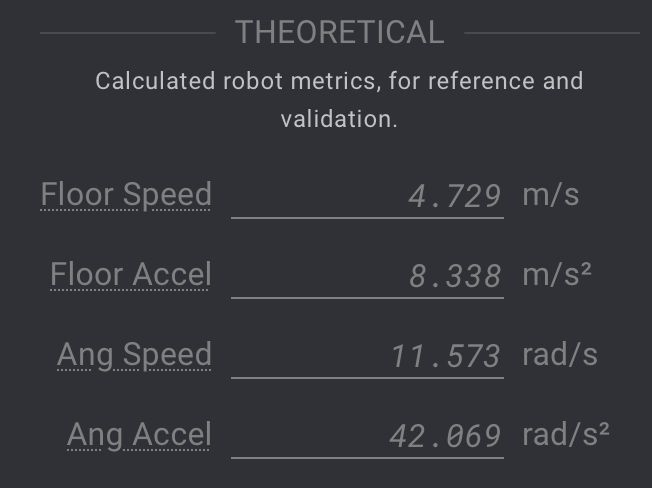Robot Configuration
The trajectory optimizer depends upon the following user-specified parameters, which are entered in the Robot Configuration panel. The more accurately you enter these parameters, the more confident you can be that your robot will follow the time-optimized trajectory on the first attempt.
Tip
While more precision is always better, you'll most likely get diminishing returns after 3-4 significant figures.
Saving Robot Config
Saving a copy of the robot config somewhere safe, like the root of a robot project, is highly recommended. This is so you can correlate that robot project to your robot's specifications, and thus your paths.
Undo + Redo
Undo and Redo shortcuts work for all of these values.
Dimensions
In this panel, enter some basic properties of your robot chassis.
- Mass \([kg]\): The mass of the robot with battery and bumpers
- MoI \([kg * m^2]\): The robot's moment of inertia, a measure of resistance to change in rotational velocity in response to a torque applied about the vertical axis
- Bumper Width and Bumper Length \([m]\): The overall size of the robot's bumper.
- Wheelbase and Trackwidth \([m]\): The largest distances between the robot's wheel centers
Drive Motor
This panel asks for details about the drive motors used to propel the robot around the playing field.
Geometric properties
- Wheel Radius \([m]\): The radius of the drive wheel
- Gearing (unitless): The ratio of \((\text{Drive motor rotations} / \text{Wheel rotations})\)
Motor performance properties
These values should be determined by consulting the motor's documentation.
- Motor Max Speed \([\text{RPM}]\): The maximum speed of each drive motor
Choosing a Motor Max Speed
A reasonable choice of Motor Max Speed is ~80% of the free speed of the drive motor(s). Although your motors have more speed available, this headroom helps ensure that your robot is able to close any errors and return to the planned trajectory.
- Motor Max Torque \([N * m]\): The maximum torque applied by each drive motor
Choosing a Max Torque
A reasonable choice of Max Torque is that corresponding to a current draw of approximately 1.5 * BreakerValue experienced at the drive motor(s). Although your motors have more torque available, this headroom helps ensure that your robot is able to close any errors and return to the planned trajectory. Use the motor's manual or published performance curves to determine an appropriate value.
Theoretical
This panel displays calculated metrics about your robot, for reference and validation.

- Traction Accel Limit \([m/s^2]\): The robot's maximum acceleration before wheels begin slipping
- Motor Accel Limit \([m/s^2]\): The robot's maximum acceleration based on motor torque
- Floor Speed \([m/s]\): The maximum speed reached by the robot when driving in a straight line and not rotating
- Floor Accel \([m/s^2]\): The maximum acceleration reached by the robot when driving in a straight line and not rotating. The minimum of traction and motor limits.
- Ang Speed \([rad/s]\): The robot's maximum angular speed when spinning in place
- Ang Accel \([rad/s^2]\): The robot's maximum angular acceleration when spinning in place